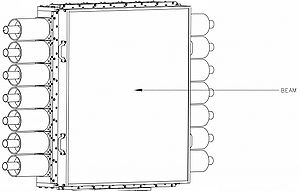Difference between revisions of "MainPage:Nuclear:KaonDetector"
| Line 20: | Line 20: | ||
[[File:detector.jpg|thumb|300px|left|Aerogel detector drawing (by Bert Metzger)]] | [[File:detector.jpg|thumb|300px|left|Aerogel detector drawing (by Bert Metzger)]] | ||
| + | |||
| + | The idea behind an aerogel detector is to make possible the trigger of events (particle) from a nuclear reaction for the selection of particles momentum. Together with other information on the experiment (e.g. beam energy and spectrometer angle), it makes possible the particle identification (PID) from a nuclear reaction. | ||
| + | |||
| + | Due to a threshold that happens in a | ||
The detector will feature three trays of aerogel, each with a different refractive index. This design will provide the flexibility to change the threshold on the momentum selection of the particles, and thus cover the full kinematic range needed by the experiments. Aerogel material of two refractive indices is already at hand. | The detector will feature three trays of aerogel, each with a different refractive index. This design will provide the flexibility to change the threshold on the momentum selection of the particles, and thus cover the full kinematic range needed by the experiments. Aerogel material of two refractive indices is already at hand. | ||
| − | Besides the detector construction itself, some tools are being developed for the characterization of it. Simulations (e.g. on the interaction of particles with the detector and on the optics of the detector for the PMT measurement) and components characterization (e.g. ) are being developed by the group. | + | == Tools for the detector characterization == |
| + | |||
| + | Besides the detector construction itself, some tools are being developed for the characterization of it. Simulations (e.g. on the interaction of particles with the detector and on the optics of the detector for the PMT measurement) and components characterization (e.g. PMT and aerogel blocks characterization) are being developed by the group. | ||
The reports on each part of the work on the detector can be seen in the following link: | The reports on each part of the work on the detector can be seen in the following link: | ||
Revision as of 19:13, 15 October 2011
As part of the upgrades on the Hall C at JLab, a new Kaon Aerogel Detector is under construction by a collaboration of researchers on Particle Physics, lead by Dr. Tanja Horn.
The main purpose of this detector is to be part of the new spectrometer that is being constructed at Hall C, the SHMS.
For the execution of the project, a consortium was established with the following institutions:
- The Catholic University of America
- University of South Carolina
- Mississippi State University
- Florida International University
Two other partners are also engaged on this project, as unfunded institutions:
This project is founded through a NSF grant: PHY-1039446.
General Aspects on the Detector
The design of this detector is based on proven technology and benefits from many years of experience that JLab acquired on the usage of aerogel detectors.
The idea behind an aerogel detector is to make possible the trigger of events (particle) from a nuclear reaction for the selection of particles momentum. Together with other information on the experiment (e.g. beam energy and spectrometer angle), it makes possible the particle identification (PID) from a nuclear reaction.
Due to a threshold that happens in a
The detector will feature three trays of aerogel, each with a different refractive index. This design will provide the flexibility to change the threshold on the momentum selection of the particles, and thus cover the full kinematic range needed by the experiments. Aerogel material of two refractive indices is already at hand.
Tools for the detector characterization
Besides the detector construction itself, some tools are being developed for the characterization of it. Simulations (e.g. on the interaction of particles with the detector and on the optics of the detector for the PMT measurement) and components characterization (e.g. PMT and aerogel blocks characterization) are being developed by the group.
The reports on each part of the work on the detector can be seen in the following link:
